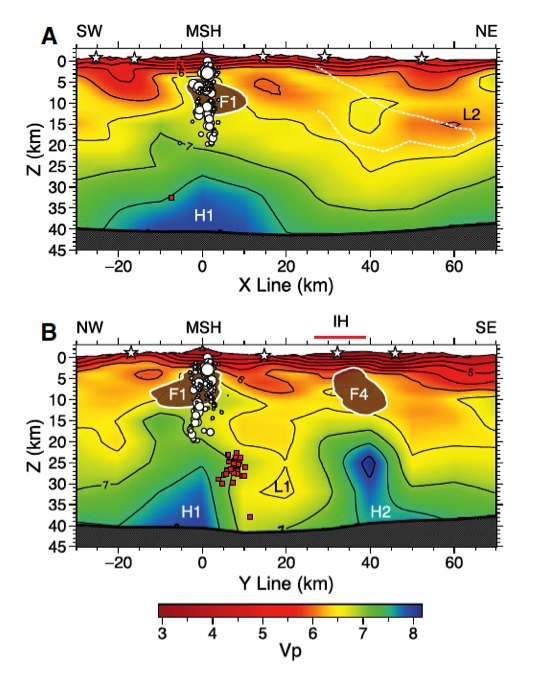 Figure caption: Cross sections across the study area intersecting at Mt. St. Helens showing the modeled P-wave velocity, Vp, and regions with high Vp/Vs (brown transparent regions; F1 and F4). The white dots are earthquakes associated with the 1980 eruption. Red squares are deep, long-period earthquakes. The dashed white line in A is the location of the southern Washington Cascades Conductor. The H and L areas are marking regions of high and low Vp anomalies. MSH – Mount St. Helens; IH – Indian Heaven. Figure caption: Cross sections across the study area intersecting at Mt. St. Helens showing the modeled P-wave velocity, Vp, and regions with high Vp/Vs (brown transparent regions; F1 and F4). The white dots are earthquakes associated with the 1980 eruption. Red squares are deep, long-period earthquakes. The dashed white line in A is the location of the southern Washington Cascades Conductor. The H and L areas are marking regions of high and low Vp anomalies. MSH – Mount St. Helens; IH – Indian Heaven. |
by Dr. John Taber
The subsurface geology of Mount St. Helens has been well studied using various geologic and geophysical methods, and scientists agree that the primary magma reservoir lies between 5 and 12 km directly below the volcano. However, the multidisciplinary iMUSH project now reveals a more detailed and complicated plumbing system beneath the volcano. Because the volume of magma and connectivity of magma chambers directly influence the frequency and size of volcanic eruptions, it is critical to understand the volcanic plumbing that lies beneath active volcanoes like Mount St. Helens.
This project utilized data from regional earthquakes and borehole shots at ~6000 individual seismograph locations, many of which were supplied by IRIS PASSCAL. Two-dimensional modeling of travel times from direct and Moho reflected P and S waves show a high Vp/Vs anomaly under Mount St. Helens. The top of this anomaly is the top of the primary magma chamber, which lies at ~4 km below sea level. This is in good agreement with previous studies. The bottom of this anomaly corresponds with clusters of earthquakes at 13 km below sea level and this marks the bottom of the chamber. However, high Vp/Vs anomalies also exist to the southwest, northwest and southeast of the volcano. The southwest and northwest seismic anomalies can be attributed to an accreted terrane, but the southeastern anomaly lies beneath the Indian Heaven volcanic field and may have a magmatic origin. Additionally, there is a low Vp anomaly to the southeast of Mount St. Helens that is adjacent to a cluster of deep long-period earthquakes that may be associated with the injection of magmatic fluids into the middle and lower crust. These results imply that there are two magma reservoirs underlying the Mount St. Helens region; however, lack of seismicity between the reservoirs may mean they are only connected by a series of small conduits. These findings have implications for the size and frequency of eruptions that can be expected from the most active volcano in the Cascades.
Publication:
Kiser, E., Palomeras, I., Levander, A., Zelt, C., Harder, S., Schmandt, B., Hansen, S., Creager, K., Ulberg, C., 2016, Magma reservoirs from the upper crust to the Moho inferred from high-resolution Vp and Vs models beneath Mount St. Helens, Washington State, USA, Geology, v. 44, n. 6, p. 411-414, doi:10.1130/G37591.1.